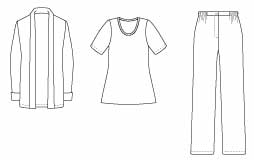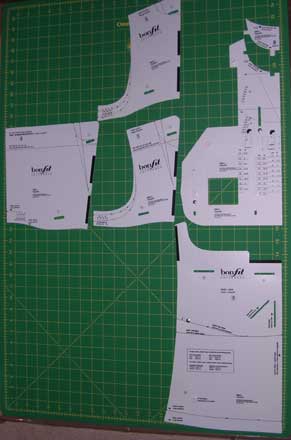I’m looking at the new styles for spring/ summer, and it seems that anything goes.
UK Elle (February 2010) :
“who do you want to be this season ? the s/s 2010 catwalks offer the chance to define your style with the strongest and most diverse looks we’ve seen for years.”
and Nancy Erickson (January 2010 newsletter) :
“For nearly everything that is “out of style” you’ll find a designer somewhere, someplace showing just that item.”
It’s a good season for making your own decisions.
So what are the rules for ignoring stylists’ advice 😀
– – –
1. Ignore specific recommendations about colour :
For example I look terrible in black, for others the culprit is white. Instead know your own best colours. Unless you are clearly one of the basic 4 seasons, you need a more detailed scheme, or a personal one. When I was younger I fit into the Color Me Beautiful 12 categories, though I needed expert help to find the right one. Now the contrasts in my colouring have softened and slightly muted, I don’t fit easily into any category, and find my best colours by knowing my skin/ eyes/ hair tones, and by trial and error.
Know at least your best darker neutral, best lighter neutral, a favourite accent colour, and another accent for a bit of contrast. What a waste to wear a colour that you don’t look your best in.
And check and revise your colours every decade (including how you re-colour your hair if you do), as your skin and hair tones change.
2. Ignore recommendations about specific shapes of garments :
For example small busted people are not flattered by close fitting tops, though many other people look good in them.
Instead know what flatters your body shape. Either do this by trial and error, or start from someone’s categories of body shape and what they suggest for each. (Or sketch on a croquis for the advanced. Sadly snoop shopping only works well for people who’re a fairly average shape.) Unless you fall easily into one of the basic 4-5 body shapes, as used by Vogue patterns or the Palmer-Pletsch newsletter for example, find a more detailed system, such as Trinny and Susannah’s Body Shapes. (I found this very helpful, but some people find it infuriating.)
I also need to know more body shape detail, as simple categories don’t include such things as sloping shoulders, high hips, relative length above and below the waist, or how your ‘around’ measurements are distributed from side-to-side or front-to-back. These can greatly affect what looks good on you. You learn this by trying to get commercial patterns to fit ! And take photos of yourself from the side as well as the back. . .
Again, revise your personal body shape knowledge and bra size at least every decade. During and after pregnancy, people need to check every few months.
3. Ignore recommendations about specific types of garment :
e.g. Little Black Dress, or denim jeans. What clothes you need depends so much on your lifestyle and the requirements of your workplace.
Also ignore recommendations about specific numbers of garments: These too depend on lifestyle. Just use these numbers to check for important gaps in your wardrobe.
Again review this every decade, or whenever you have a big lifestyle or job change.
4. Ignore recommendations about specific styles of garment :
I for example am very unhappy in a classic blazer, while my mother forbade blue jeans (not my colour, but guess what I wore when I left home 😀 ) Find your personal style. Here as well, there can be a ‘big 4’ of categories – such as classic, romantic, casual, fashion forward. I find I like a little of many styles, one of the reasons why I enjoy reading wardrobing advice ! Casual predominates in my wardrobe, but with touches of classic, chic, pretty, boho, current. . . generally quiet. I confess that Sporty, HipHop, Dramatic, Goth, and Lolita pass me by.
People also differ in whether we like to make big or small changes as we are finding our own style. And in how much we care about whether we fit in with the neighbours. And how to adapt our own style to fit in with another one if need be.
It’s also good to know the clothing code for your workplace, and how to adapt your own style to suit, as this may affect your income.
It’s not so important to check personal style every decade, as most people don’t change. But I know two people who’ve changed their style dramatically, so you might give it some thought.
5. Ignore recommendations about specific styles for a specific age :
“No woman over 40 should. . .” is a phrase I think should be banned. Yes, adjust your wardrobe because of changes in colouring, body shape, mobility, lifestyle. But not just because you’re ‘old’.
Stop wearing tight pants because you no longer have a shapely butt, not because you’re 50. (I grew up at a time when women only wore pants for sport, and never tight enough to ‘display themselves’. But I’ve never had a good backside to display anyway.)
If you’ve got good legs, then celebrate them. There were a couple of grannies in last year’s ‘Strictly Come Dancing’ (US ‘Dancing with the Stars’). They showed the full length of their legs to great effect. While some of the younger ones were embarrassed about it. So if you’ve still got shapely legs, and it’s your style to show them, then good for you.
If you are a quirky style of person, you should still be wearing quirky clothes when you’re 70, not just when you were 17. If you’re a refined style of person, you should be wearing refined clothes when you’re 17, not just when you’re 70. Yes of course, as the years pass, adjust what you wear so it is flattering to your current body and self and adapts to changes in lifestyle. But don’t change it because you are ‘old’. How sad to restrict your life unnecessarily.
P.S. If you’re really convinced that you must dress dull as you get older, then have a look at Advanced Style.
The advantage of being young is that you can get away with being very unflatteringly dressed. At any age, focus on finding what is best for your colouring, shape and style. Pick from the recent patterns, and off you go 😀
– – –
Most wardrobe advice suggests a small collection of well coordinated garments. But even that isn’t to everyone’s taste. It’s just a good starting point if you want to be sure you have something to wear for all occasions, or if you’re trying a new style, or if you want a plan for what best to sew next.
I think the most important thing wardrobe plans do is stimulate thinking about what is best for us as individuals. To be our best we each need to know :
– our best colours,
– our body shape and what flatters it,
– our lifestyle and what clothes are needed for it,
– what our personal style is.
And there are some heart and head questions about specific garments :
– do I love it ?
– does it make me look and feel special ?
– does it fit ?
– is it in good condition ?
– what else does it go with to make an outfit ?
– could it play a major part in my life ?
Even though these comments are so general, some people will disagree with them ! Notice your disagreements, and what you dislike about a season’s new styles, as they give you strong hints about your own personal style.
And of course you can ignore everything I say 😀





















